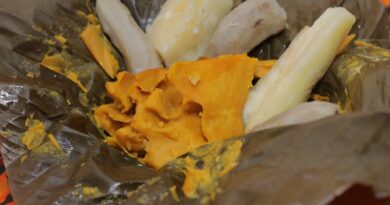Nshima
Nshima: The Heartbeat of Zambian Cuisine
Introduction:
In the heart of Southern Africa, where vibrant cultures and traditions intersect, one culinary masterpiece takes center stage – Nshima. This staple dish of Zambia is more than just a meal; it’s a symbol of community, a testament to the rich agricultural landscape, and a journey into the soul of Zambian cuisine. In this article, we will explore the origins, preparation, cultural significance, and the sensory delight that is Nshima.
Origins of Nshima:
Nshima, also known as ubwali or sadza in other African regions, has deep roots in Zambia’s history. The dish is a reflection of the country’s reliance on staple crops, primarily maize, which is a dietary cornerstone for many communities across Southern Africa. As maize cultivation became integral to the region, the art of transforming maize meal into Nshima became a culinary tradition passed down through generations.
Ingredients:
At its core, Nshima is a simple dish with minimal ingredients, yet its preparation requires precision and skill. The primary ingredient is maize meal, finely ground from dried maize or corn. Water is added to the maize meal to form a thick, starchy porridge-like consistency. The result is a smooth, elastic dough that is the foundation of Nshima.
Preparation:
The preparation of Nshima is an art form, requiring patience, practice, and a deep understanding of the desired texture. The process begins by bringing water to a boil and then gradually adding maize meal while stirring continuously to avoid lumps. The mixture thickens as it cooks, and the constant stirring prevents the formation of clumps.
The key to perfecting Nshima lies in achieving the right consistency – a soft yet firm dough that can be easily molded. The cook must continually knead and turn the mixture until it reaches the desired texture. Once ready, the Nshima is shaped into smooth, round portions, each resembling a small mountain on the plate.
Cultural Significance:
Nshima is more than just a source of sustenance; it is a cultural cornerstone that binds communities together. Traditionally, Nshima is served communally, with family and friends gathering around a shared dish. The act of breaking off a piece of Nshima and using it to scoop up accompanying relishes creates a sense of togetherness and unity.
In Zambian culture, Nshima is a symbol of hospitality and generosity. Guests are often welcomed with a steaming plate of Nshima, accompanied by an array of relishes such as vegetables, meats, and fish. The communal nature of Nshima fosters a spirit of sharing, reinforcing the bonds between individuals and creating a sense of belonging.
Variations and Accompaniments:
While the basic recipe for Nshima remains consistent, some regional variations and accompaniments add diversity to the dish. In urban areas, people might opt for whole wheat or other grains to create a healthier version of Nshima. Additionally, side dishes such as ndiwo (relishes) made from vegetables, meats, or fish, contribute to the overall dining experience, providing a burst of flavors that complement the simplicity of Nshima.
Nshima is often served with a variety of relishes, including ifisashi (vegetable stew), kapenta (dried fish), or nyama (meat). The combination of the neutral, starchy Nshima with the bold, flavorful relishes creates a harmonious balance that satisfies both the palate and the senses.
Celebrations and Rituals:
Nshima plays a central role in Zambian celebrations and rituals, marking significant events such as weddings, births, and communal gatherings. The dish is not only a symbol of abundance but also a way of expressing cultural identity and pride. In rural areas, the act of preparing and sharing Nshima is accompanied by traditional songs and dances, creating a festive atmosphere that transcends the dining experience.
Nshima is also an essential element of Zambia’s diverse religious and spiritual ceremonies. Its presence on the table signifies a connection to the land and the seasons, acknowledging the importance of agriculture in sustaining life.
Nshima in the Modern Context:
In recent years, Nshima has transcended its traditional roots to become a symbol of Zambian national identity. It is a dish that unites people across diverse backgrounds, reflecting the country’s rich cultural tapestry. While the preparation methods may have evolved with the introduction of modern kitchen appliances, the essence of Nshima remains deeply rooted in tradition.
The dish has also garnered attention on the international stage, with food enthusiasts and chefs discovering the unique flavors and cultural significance of Nshima. Its simplicity, combined with the ability to pair it with a variety of relishes, makes Nshima a versatile and adaptable dish that resonates with people around the world.
Conclusion:
Nshima is more than a meal; it is a journey into the heart of Zambia’s rich cultural heritage. Its origins in the agricultural landscape, the meticulous preparation process, and the communal act of sharing all contribute to the unique identity of Nshima. As Zambia continues to embrace its culinary traditions, Nshima stands as a symbol of resilience, community, and the timeless connection between food and culture. So, the next time you find yourself in Zambia or exploring African cuisine, don’t miss the opportunity to savor the heartbeat of Zambian culture – a plate of warm, comforting Nshima.



